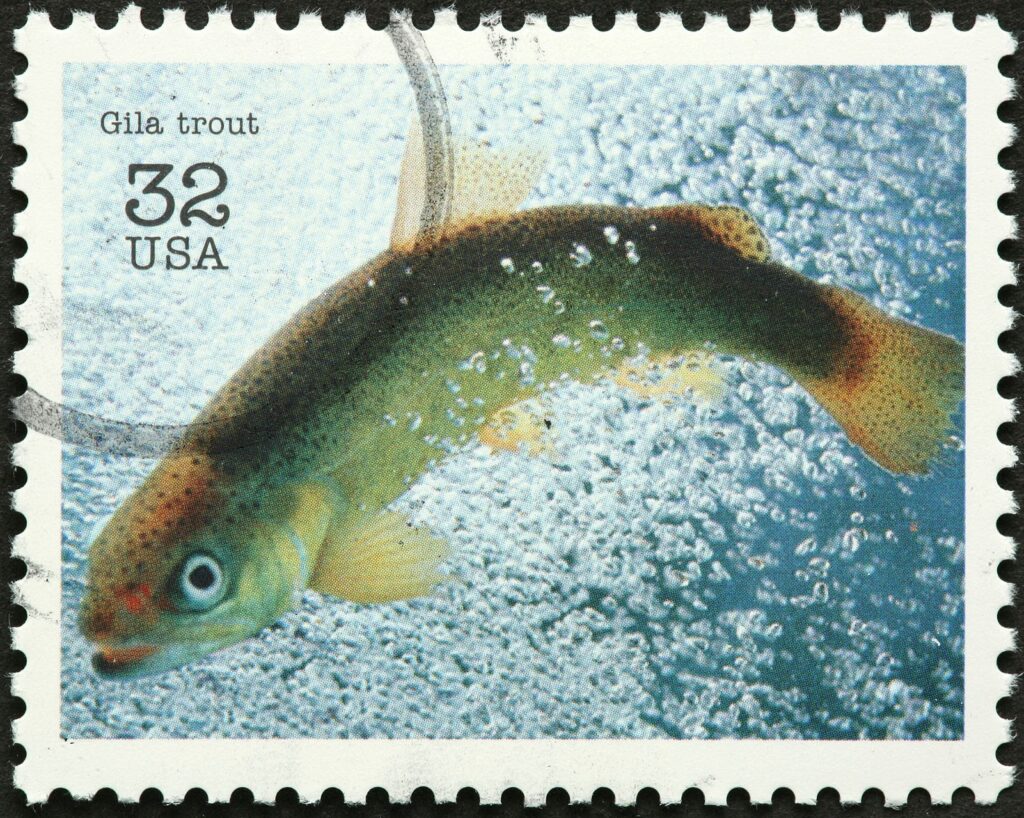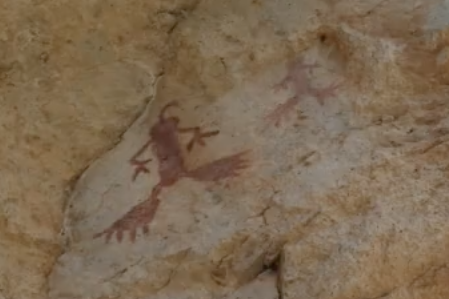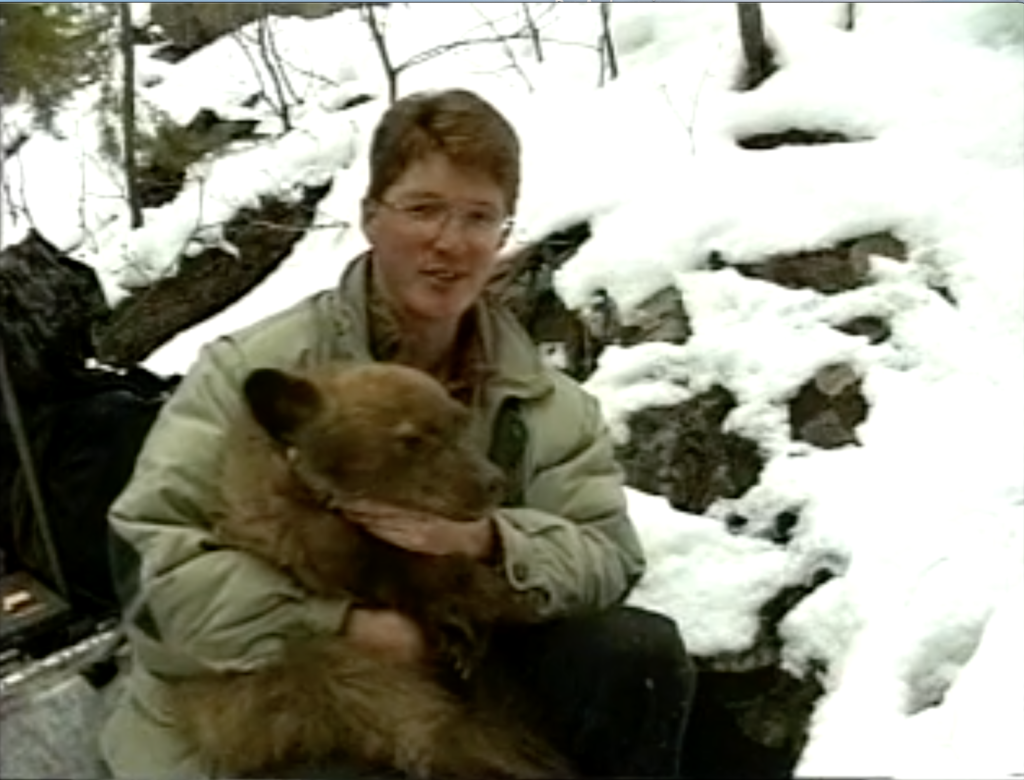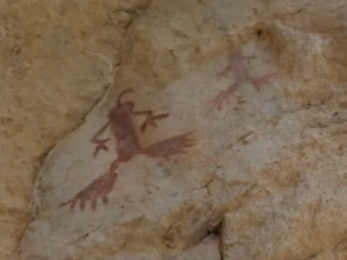by Walter Ratliff
On a hot summer day in June 1996, I set out to cover a story in a remote part of New Mexico’s Gila National Forest. Hours later I found myself face down on the trail, consciousness fading.
It was my first summer working in television news. Seven months beforehand, I had landed a job with the KOAT-TV, Albuquerque’s ABC affiliate, as a reporter in the station’s southwest New Mexico bureau. Before that, I was managing KNKT-FM, a small Christian music and talk radio station in Albuquerque. A 6,000-acre wildfire was scorching the Gila wilderness in southwest New Mexico. It was a few hours before dawn in the Mogollon Mountains on June 14 when we reached the junction between the narrow, rocky Sacaton creek and an old concrete aqueduct.
Making the hike that morning was a U.S. Forest Service ranger, myself and three Department of Game and Fish employees that looked like they had stepped out of a wild west show. One even sported a handlebar mustache. Shortly after arriving at the staging area, the cowboys opened a trailer and, with shouts of “come own” and a “git on down ginny,” unloaded our four-legged traveling companions. After a bit of convincing, three brown-eyed, bristley-coated burros stood alongside us in the darkness.
The goal for the day was to hike a few miles upstream to a pool where the Gila trout made their home. Ashes from the wildfire were headed downstream, and retreating water from the drought was putting these fish at risk. It was the job of the Game and Fish Dept. employees to locate and capture the rare species of trout, and the burros’ job to haul the stunned fish down the mountain in several gallons of their own stream water. Once out of danger, the trout would spend the rest of the year relaxing in comfort at a nearby fishery as their diminishing stream became choked with forest fire debris.
But coaxing live fish out of their habitat without a fishing hook is no easy task, much less getting all the fish in the stream out and into containers on the donkey’s backs. The cowboys had a secret weapon – an apparatus consisting mainly of a car battery and electrodes. It would shock the fish into unconsciousness , then scoop them up and load them into the burros’ panniers. It was a quirky story with the potential for interesting video, and would illustrate some of the environmental effects of the fire season. But I didn’t see any of it.
After loading the burros up with all the retrieval equipment, one of the cowboys asked if I wanted to put my bulky video camera and large metal tripod on the donkey’s back. I chose to keep my camera so I could take shots along the trail, but unburdening myself of the heavy tripod was a nice offer, thank you.
It was still about an hour before dawn when we set out on the trail. It wound along the dry creek bed over endless boulders and past occasional ancient Mogollon culture pictographs, all under a canopy of tall, ponderosa pines with bark like a matted jigsaw puzzle. Our little band walked one mile and then two, with my tripod bobbing to the left and right on the burro’s back as we went. As we climbed up the stream’s course, we saw a few decrepit mining cabins, most with a wall or two fallen in and the breeze blowing through the remaining slats. The sun wouldn’t peek out over the rim of the mountain range until long after nine o’clock, but the birds chirped and squawked with abandon as the ambient light poured into the forest that morning after “sunrise.”
What we didn’t see was water. We hiked for one mile, and then another, and another, but the creek remained a sand-and-rock-filled scar winding its way through the woods without a hint that it was a living stream. After rounding a few bends and topping a few more boulders, one of the cowboys remarked that the spot we were passing was where they had expected to see the pool of Gila trout. What greeted us was a depression in the dry creek bed containing nothing more than a few fallen branches and a mound of fine silt that looked as if it had deposited in days that had long passed. So we kept walking, and my tripod kept bobbing, and the water in the stream failed to appear.
As the day became brighter and we kept making our way along the edge of the stubbornly dry creek bed, I came to the conclusion that it would be a good idea to leave this merry band of cowboys and burros. My environmental impact story was turning into a wild fish chase. I told the U.S. Forest Service ranger I was heading back and would meet up with them once they returned with the trout. The last thing I noted as I headed downhill was my tripod bobbing back and forth on the burro’s back among all the other equipment used for the fish rescue. At once, they turned around an outcropping of rock – and they were gone.
So down I went, back over the boulders and past the half-standing mining cabins toward where we had parked our vehicles along the aqueduct. I was carrying my heavy camera over my shoulder and had a large torso pack filled with microphones, extra tape, cable and a short, heavy mic stand with a cast iron base. As I made my way down the trail in the morning light, I noticed it looked quite different than when we were making the hike before dawn. At any moment I expected to see the broken concrete blocks that marked where the aqueduct joined the stream.
As I descended the stream, sycamore and scrub oak replaced the ponderosa pine. I felt confident I still had a ways to go after walking by a few cabins I recognized. But passing another, and then another cabin I realized I hadn’t seen these particular ones before. Thinking that the stream we passed on the way up was the same one we crossed along the road as we drove in, I kept walking. Soon I encountered a jeep trail that followed the creek bed further down into the hill country that surrounded the mountain range. There, far from my starting point and standing alone in an unfamiliar landscape with uncertainty both upstream and down, I forced myself to come to a conclusion. I was lost.
I joined KOAT in December 1995 at age 26 as the Silver City reporter. My job was to man a bureau located two mountain ranges and a 3.5-hour drive from the main newsroom in Albuquerque. I wrote, shot, edited and reported my own stories, and occasionally went live from my office in the basement of a country-music radio station. These one-man band operations had become more common during the nineties as equipment and talent became cheaper and more plentiful. I was the second person to work for KOAT-TV in this particular bureau. The first reporter had stayed about a year, and left in a huff for a reporting job in Peoria, Illinois.
It was a bit of an adjustment to go from managing a small staff at a Christian music and talk station to my new job of squeezing news every day out of this corner of the state. Not much had happened here since Billy the Kid left in the 1870’s. To me, it seemed that the management of the station regarded me as a far off voice in a lonely part of the state when much more urgent attention and resources were needed elsewhere.
The first newsgathering rig I was assigned was an old 3/4” tape setup where the camera and deck were separate, heavy units. Most stations across the country had junked these ten years before in favor of smaller, higher-quality Betacams. During the first four months of my tenure at KOAT I had to lug around a twenty pound deck complete with umbilical cord wherever I took the equally heavy camera and, in exchange for the added heft, produced video that looked like it was shot in 1982. In April of 1996, the station purchased a Panasonic S-VHS unit where the deck was docked to the camera, and I thought my life was going to get much easier. Unfortunately, they gave me only two small batteries to go with the new camera – not quite enough power to shoot a full story without recharging. About the time I received the new camera, my computer died and I was left for months not only without email and access to wire services, but also having to hand-write my tv news scripts, or quietly steal time on an old typewriter used by the radio station to type labels, and fax them to the station.
The pain of scaling my own learning curve, plus a host of equipment and editorial challenges that sprang from a lack of support, created a situation that I was eager to leave. My morale about my recent career change was at an all time low when I entered the woods that June day.
Conventional wisdom says that you can go three days without water, and weeks without food. But what many don’t know is that dehydration can set in within a few hours. Heat exhaustion, shock and even heat stroke are not far behind when you mix a lack of water with the hot New Mexico sun and continuous heavy exercise. All the drinking water we had brought for the trip was still, for all I knew, bobbing back and forth on the back of a donkey up the dry Sacaton Creek with my former traveling companions. After a few hours of lugging my camera and equipment over the rocks and through a tangle of branches along the dry creek bed, I felt the energy quickly leave my body, and saw white spots flickering in front of my eyes. I also developed a whopper of a headache. By then it was about noon, and I could hear the buzz of a small airplane flying nearby. Knowing that this was likely to be a search aircraft, I climbed a small hill and tried to yell, wave and use anything I could to catch the attention of the plane as it zigzagged across the landscape a couple of miles from my location. Eventually, it turned down a canyon and the buzzing faded as it returned from where it came.
As I gathered up my equipment and cinched up my pack for the trip back to the creek bed, I noticed a barrel cactus about the size of a golf ball. It was thick with needles, but I knew that if I could split it open it just might offer a bit of moisture and nutrition. I did not have a knife of any kind, so I used the largest key on my key chain – the one for the rugged old Toyota Land Cruiser belonging to my station’s engineering department that was parked at the tiny local airport. The cactus and its tapered root came out of the ground without much protest, and I used the key blade to split the spiny, little orb in two. Inside it was mostly dry, but had a pinkish, tasty flesh. It wasn’t water, but the sugar in the plant seemed to give me a little energy for the walk.
After a short time, the headache, visual spots and crippling fatigue returned. At one point I lay on my stomach in the middle of a jeep trail crossing the creek bed, my consciousness fading. After an unknown amount of time, I got back up and began my hike back to where I thought I should be.
Meanwhile, back at the station, they had not received word that I was officially missing. The five-o’clock producer, angry that I hadn’t checked in, was sending sharp messages to my alphanumeric pager demanding that I check in soon and that she needed the story for that evening’s newscast. The producer said she was mortified at the thought I was getting these pages after word reached the station that I was lost. After the U.S. Forest Service notified the station, and the station notified my parents. They also sent their news helicopter to the area to see if they could spot me and, perhaps just as importantly, cover the breaking story about their missing reporter. Friends and immediate family gathered at my parent’s house and my dad pulled out maps of the area from his days as a Boy Scout leader and Forest Service surveyor to see where I might have wandered off. As the hours ticked by, everyone became very, very worried.
As the afternoon wore on, I was able to make my way a little further up the creek bed. The longer I went without water, the more my heat exhaustion worsened, and the more my mind turned toward the basics of survival. What ran through my mind was not that I would run into a familiar face or make my way out of the woods. Rather, it was thoughts of turning on the spigot from the kitchen sink or pouring a glass of lemonade from the refrigerator to cure my thirst that I thought of most. My body was crying out from dehydration, and it was playing games with my mind. But some relief was about to arrive, and it was bringing new challenges with it.
In high mountain ranges, clouds typically form near the peaks as the moist air in the valleys warm throughout the day. As the temperature cools and the moist air condenses in the high atmosphere, the clouds often produce sporadic but heavy rainfall. That’s exactly what happened in the late afternoon along Sacaton Creek. I hadn’t packed a raincoat for what was supposed to be a morning trip in the middle of a drought.
As the rains came, I huddled close to the trunk of a pine tree that was shorter than its taller (and more lightning-prone) neighbors. It had thick boughs that acted as a lousy umbrella. Before the rains, all I could think about was water. Now I had far more than I needed.
As I sat there under the pine tree, I took out the microphone stand with the cast iron base and turned it upside-down in the dirt, plugging the hole in the center with a piece of cardboard. Then I took out a paper videocassette box that still had the cellophane wrapping around it and propped it open next to the inverted mic stand. I was also carrying a microphone “flag” with the station’s logo printed on the side. Inside was a sponge that I used to soak up the water that was drenching my camera and squeeze water into my mouth. After a few minutes the mic-stand/water-collector, the plastic covered videotape box and a few other items from my newsgathering kit had filled, providing me with enough of the much-needed water to satisfy my thirst.
It must have rained for an hour. It cured my dehydration problem and also cooled me down. I was still in danger of catching hypothermia. I walked on as the shadows on the trees began to lengthen.
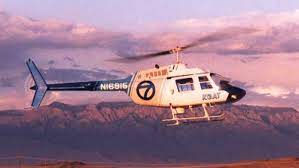
It was still a couple of hours before sunset when I heard the rapid beating of chopper blades in the distance. The sound grew louder and louder, and I realized shortly that it was headed straight down the little valley toward me – and at low altitude. I quickly ran toward a wide part of the streambed and picked up a fallen branch that was a little more than six feet long.
As the blue and white helicopter that a week beforehand I was shooting aerials of forest fires passed no more than 100 feet over my head I spotted a Circle-7 logo on the side. It was my station’s news helicopter, and there was a photographer pointing a camera out of the window and toward the ground. I yelled as loud as I could and waved the long branch around in circles. But it kept going, and soon the sound of “Sky-7” was replaced by the quiet of a forest in the early evening.
I decided at that point that with sunset coming shortly I had better prepare for spending the night. As a teenager I belonged to Royal Rangers, a church group similar to the Boy Scouts. Among other things, I learned in the group wilderness survival skills that I never thought I would need (and some basic things I had clearly forgotten). My clothes were still damp from the rain and I decided my first priority was to make a shelter. Drawing from my survival training experiences a full ten years before, I wedged one end of the thick branch that I had waved at the helicopter into the fork of a tree about three feet off the ground. I then laid some pine boughs and medium-sized sticks along the edges to form walls, and added more sticks in crisscross fashion to build up the walls of the shelter. I then scoured the area for pine needles and leaves to cover what was turning out to be a small, but pretty decent shelter.
By the time I finished, the sun had already set, and light was quickly fading. I tried turning on the camera, but the only sign of life it showed was a flashing “E” on the LCD panel. It was toast. I climbed a small hill above my campsite to see if I could get my bearings, but the only thing I spotted that was of use was another barrel cactus. Instead of being small and round like the one I found earlier in the day, this one was as long as my hand and oval-shaped.
Pleased with my small amount of fortune, I took the Toyota Land Cruiser key and carefully split the cactus open. Inside, what was going to serve as my supper was green and gooey – not dry and pink like the cactus I had for a mid-afternoon snack. I lifted a chunk of the cactus to my mouth and ate some of the green goo. It was disgusting – very “planty,” and not in the slightest bit sweet. I ate about half of the cactus’s gooey flesh and set it on a rock a few feet from my shelter. I would have to be really hungry before I tried it again. And besides, I told myself that there were probably other easy-to-find edibles around, such as dandelions.
The rain clouds that brought the afternoon showers were long gone by the time darkness fell. As my eyes adjusted to the moonless night, I could see the Milky Way through the high branches above me, and a faint orange glow from the forest fire several miles east of my humble campsite. The only sounds were the faint whoosh of the wind through the trees and the barking of coyotes. Cold and exhausted, but not particularly sleepy, I decided to climb into my makeshift shelter and try to get some rest. My clothes had dried for the most part, but the slightest breeze would still produce a chill. Getting out of the weather, no matter how calm, seemed like the smart thing to do.
As I lay there in my shelter I had a brainstorm. I remembered once as a teenager in Royal Rangers trying to start a fire using steel wool and “D” size batteries. I didn’t have those items, but I did have camera batteries and microphone cord. I reached down into my equipment bag and pulled out on of my XLR mic cables and chewed the plastic insulation off. I then tugged as hard as I could, pulling the connector loose from the bare cord. A few inches down the cord I bit down on the cable to sever layers of insulation and wiring inside. After a bit of chewing, I ended up with two segments of frayed microphone cable, about six inches apiece.
I wiggled out of my shelter and hunted around for dry pine needles and leaves, and looked in my wallet for dry business cards. Unfortunately, everything was soaked – even deep underneath the base of the trees. I thought it was still worth an attempt, so I pressed the ends of the frayed cable to the positive and negative points on the battery and an orange glow began to form at the center of the cable segment. The points where the cable met the battery were getting extremely hot too, and I had to let go after a few seconds.
After a few tries, using leaves and wet cards as insulation for my fingers, I gave up. The material I was trying to ignite was simply too wet, and the mic cable was disintegrating before it would ignite itself. There would be no fire tonight. I climbed back into my shelter and covered myself with dirt and pine needles to keep warm and drifted off. The only interruption was a heavy thud just outside my shelter followed by a fast rustling sound. I took it to be an elk or other large animal that I must have startled when I turned over in my sleep.
When I next opened my eyes, it was still pitch black – but there were voices outside. I scooted up a few inches to look out of my shelter and saw the sweep of flashlights against the streambed, and heard the chatter of people engaged in light conversation. I quickly extracted myself from my piney cocoon, and stood on the same rock jutting out into the creek where I had waved at the helicopter.
“Hey! I’m over here!” I yelled to the search party. By this time they had walked about 50 feet past my campsite. Because there was no moon, the only light came from their flashlights, and anything outside of their sweep was invisible. “Keep yelling,” they shouted back.
After a few minutes of “you’re getting hotter” and “you’re getting colder” the light from a searcher’s flashlight swept up from the ground and beamed directly into my eyes.
“Can’t a guy get any sleep around here?” I told them as the light of four flashlights fell on my face. It was about two a.m.
“Are we glad to see you,” one said as they approached. The search party consisted of two women I estimated to be in their late 20’s, a man in his thirties, and a bearded Vietnam veteran named Dave Berry. We sat down next to my shelter and they gave me water to drink and some warm clothes to wear. Dave produced a foil-wrapped burrito from his daypack and handed it to me. Perhaps because my palate was still a bit sensitive from a lack of water earlier in the day, the red chile inside the burrito sent a searing pain across my mouth, like the spice was forming a cut in my mouth – and it stayed sore for about a week and a half. This was the only physical wound that I carried with me out of the forest that morning.
The five of us drank water, ate and talked around the flames of a portable stove. Dave told me that normal procedure when they discover a person alive during a search and rescue operation is to measure the person’s core body temperature using a rectal thermometer. He said that because I was joking with them when I was discovered, they figured I must have been in good shape. I told him the burrito he just gave me would have cured any issues about a low body temperature.
After about half an hour, we gathered up our things and prepared to leave. I showed them my shelter and how I tried to start a fire, and we headed downstream toward the jeep trail that I had zigzagged across several times the previous day. It was almost exactly 24 hours after I had set out with the burros and the cowboys on the fish rescue story when I reached my vehicle, a few miles from where I had stopped for the night. A note was on the windshield asking me to call in if I came made it out on my own. I climbed in the car and drove up to the search command center. The nylon canopy, which sheltered radios, maps and search and rescue personnel, was lit by a series of Coleman lanterns and one very bright news camera light.
As I stepped out of my vehicle and walked alone toward the lights I called out, “You lookin’ for me?”
I recognized my assignment manager from the station, Dave Lopshire, and one of the station’s photogs, Tim Baca. A search and rescue coordinator lead me to a map and we discussed for a time where I thought I was, and where they thought I might have gone. After working through the details, myself, the photographer and assignment manager headed back into town. I had just enough time to shower, take a quick nap, put on some clean clothes and tell my story on the noon news program.
Epilogue
My experience in the woods made me rethink how I was approaching my job at KOAT. For the first seven months of the job, I was trying my best to leave. I had already sent out a number of resumes and spoken to a couple of different news outlets in smaller markets. It may not be noble, but after this experience I simply felt that it would look bad if I suddenly left my job. The appearance would be that I had been embarrassed into giving up my position. I was far too vain for that. My new goal was to make this bureau a success. Before, the lack of technical support and disinterest in the stories I had to offer made the situation unbearable. Afterwards, the assignment desk, manned by a different person than when I had started the job, was more receptive to what I had to offer. The management, seemingly just discovering that I was working for them in the far-flung bureau, now provided me with the basic equipment I needed to get the job done.
A year later, I left Silver City, NM for a job as a news photographer for international clients in Washington, DC. By the time I had left, I had developed a reputation at the station for being both a very decent photog as well as a good writer. I still ventured into the woods on stories – most memorable was a trek through the snow to do a story on hibernating bears in their den.
My experience during those 24 hours in the woods was also a catalyst to reintroduce me to the corner of the state I was covering. The country music radio station where my office was housed happened to also be the most listened-to station in the area. Although I went on the air only occasionally with this station, my experience and subsequent comings and goings quickly became a good-natured recurring subject on the morning radio program heard by just about everyone in the region. When I met someone new in the field, chances were that they already knew me by way of “J.R. and Cary,” the weekday morning show personalities. With the crucial support from the staff and management at KOAT-TV, and a little help from a couple of morning radio personalities, I had met the challenge I imposed on myself to come out of that job on a very positive note. I also carried a lighter, knife, poncho, snack and water on every assignment after that.
###
Images
- Google maps
- Gila trout stamp (U.S. Postal Service)
- Frog-man pictographs, Sacaton Creek, NM (G. Ray Photography)
- Mining Cabin, Sacaton Creek (G. Ray Photography)
- Screen capture of studio report (Walter Ratliff)
- “Sky 7” helicopter (KOAT-TV)
- On assignment holding a bear cub (Walter Ratliff)

